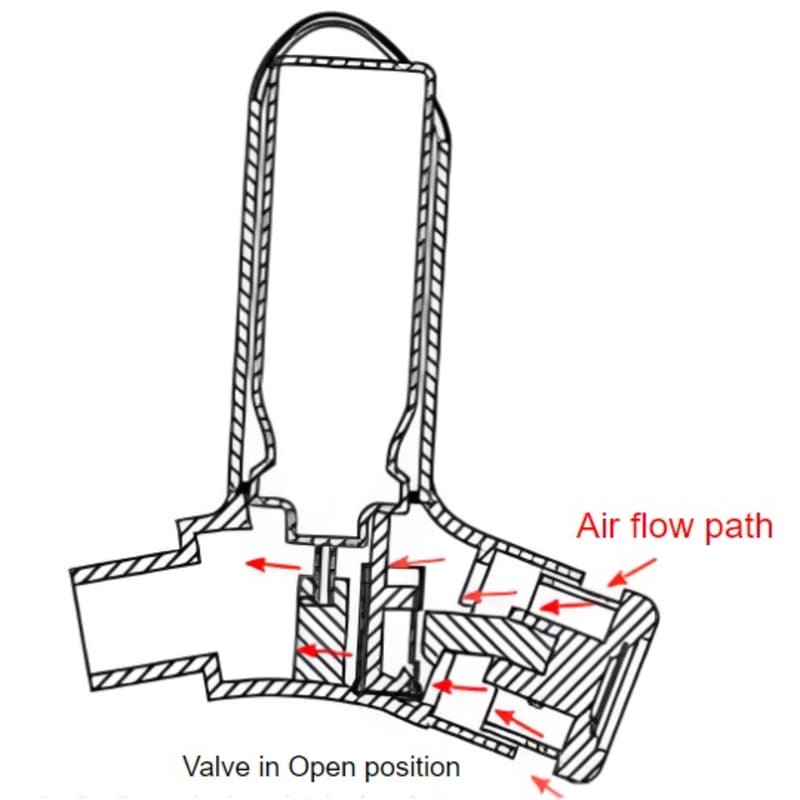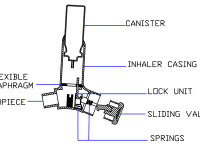
THE PROBLEM:
Asthma affects over 300 million people globally, with significant mortality rates, particularly in India, contributing to 42.4% of global asthma deaths. Traditional inhalers face two critical issues: lack of synchronization of inhalation and medication release, and improper mixing of medication with air. These issues lead to inefficient drug delivery, with less than 37% of medication reaching the lungs effectively.
OUR SOLUTION:
The Valved Asthma Inhaler consists of a single air passage for both air and medicine to flow. The gap between canister and inhaler casing is sealed by a flexible diaphragm. One end of the passage fits into the user's mouth, while the other end connects to a valve. When the valve is closed, the apparatus forms an airtight chamber.
To use the inhaler, the user places the mouthpiece in their mouth and begins to inhale. Initially, no airflow occurs due to the closed valve, creating negative pressure within the passage. The user then presses the canister without needing to coordinate the actions. The lock mechanism ensures that when the medication is released, the valve opens simultaneously, allowing air to flow in.
Negative pressure draws in high-velocity air, causing turbulence that thoroughly mixes air and medication. This reduces aerosol size, ensuring effective delivery to the deeper parts of the lungs.
Our product assures to be at least 23.8% more efficient than existing inhalers.
NOVELTY:
- Controlled Air Passage: Ensures synchronized airflow and medication release.
- Valve Mechanism: The sliding valve opens in response to the canister's depression, addressing coordination issues common in traditional inhalers.
- Hook Lock Unit: Regulates valve movement with a spring mechanism for precise timing.
- Particle Size Reduction: Turbulence in airflow reduces particle size, improving drug absorption.
- User-Friendly Design: Simplifies use, benefiting children, the elderly, and those with coordination difficulties.
- Efficient Drug Delivery: Higher medication efficiency with minimized wastage.
MANUFACTURABILITY:
The manufacturing techniques are similar to traditional inhalers, utilizing plastic injection molding. Components such as springs and diaphragms can be outsourced and assembled. This approach ensures cost-effective production, with manufacturing costs only slightly higher (INR 5-10) than traditional inhalers. The design is easy to prototype and scale, with two functional prototypes already made. The affordability and efficiency of the product make it highly feasible for mass production.
APPLICATIONS:
- Respiratory Diseases Management: Treats asthma, COPD, and bronchitis.
- Emergency Medicine: Suitable for acute asthma attacks.
- Home Healthcare: Enables self-management of chronic respiratory conditions.
- Pediatric and Geriatric Care: Facilitates use by children and elderly patients.
MARKET:
With over 300 million asthma patients globally, the market potential is vast. The metered dose inhalers market is projected to grow significantly at a CAGR of 4.5% from 2023 to 2033, reaching US$ 40,895.5 million by 2033. The Valved Asthma Inhaler, offering improved efficiency and user compliance, stands to capture a substantial market share.
By addressing critical issues in traditional inhalers with a novel, user-friendly design, the Valved Asthma Inhaler represents a significant advancement in respiratory disease management, poised for wide adoption and commercial success.
Video
-
Awards
-
 2024 Top 100 Entries
2024 Top 100 Entries
Like this entry?
-
About the Entrant
- Name:Arvind Palanikumar
- Type of entry:teamTeam members:
- MUHAMMED ASLAM S
- Patent status:pending









